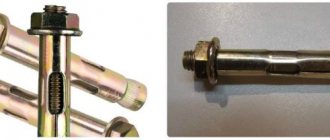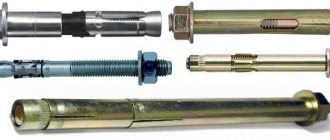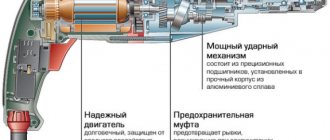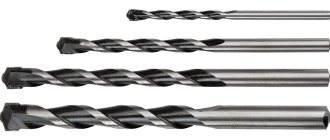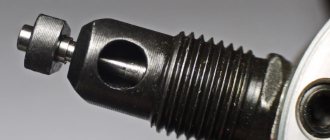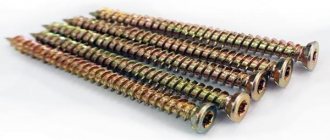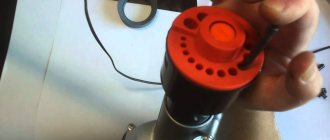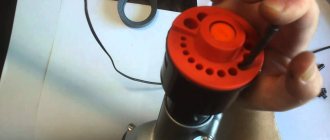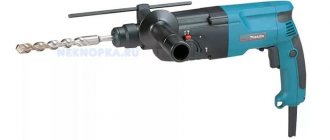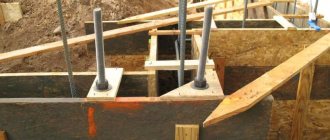A hammer drill for concrete is a specific work accessory that, among household electric tools, is used exclusively with rotary hammers. Concrete drills are used when performing repair work and are classified according to various parameters: design, type of shank, as well as the geometric parameters of their spiral part. Novice craftsmen are often interested in how to choose a drill for a hammer drill.
What is a drill chambered for a hammer drill?
When performing repair and construction work, you will need the presence of power tools. Previously, hand drills and rotary hammers were used to drill through concrete or wood, but progress does not stand still. To facilitate the work of drilling wood or metal, an electric tool called a drill was developed. It is impossible to drill concrete, brick and various types of artificial stone with a drill without an impact option, which is why hammer drills appeared.
To drill a hole in concrete, you need to install the appropriate nozzle in the device socket. Structurally, this attachment looks like a drill bit, but there are still differences. The drill device for a concrete hammer drill consists of the following parts:
- Shank - part placed in the main tool chuck
- The spiral is the working part, its main purpose is to remove the remains of drilled concrete and dust from the hole
- The cutting part is a base made of special carbide materials - pobedite or diamond sputtering
The structure of the drill resembles a drill, only for a hammer drill it is necessary to install the appropriate attachments with a special shape of the tail section. The drill for the hammer drill serves as a consumable material, and is used to make holes in concrete, reinforced concrete and other similar materials. It is impossible to drill metal or wood with such a nozzle, since it will not be able to cope with such tasks, which is due to the specific design of the cutting part. The efficiency of drilling work depends not only on the type of tool used, but also on the design of the nozzle itself.
This is interesting!
For hammer drills, they produce not only attachments for working on concrete, but also drills for drilling woodworking materials.
Pobedite or diamond tip: which is better?
It is impossible to answer unequivocally which material is better for a carbide cutting insert. Diamond and will win are designed to perform different tasks:
- Diamond attachments are intended for processing concrete structures (including reinforced concrete) and stone blanks. They are characterized by high wear resistance.
- Pobedite tips will be more useful in domestic use, as they are often used when drilling masonry and low-quality weak concrete.
Working part of the drill, types of spirals
According to the design of the spiral part (working area), concrete drills for hammer drills are:
- Screw - due to the large angle of inclination of the groove, it becomes possible to obtain deep holes. The spiral design in the form of an auger allows dust and concrete particles to be effectively removed
- With small angles of inclination of the spiral part or spiral - these types of drilling attachments are used when you need to get a hole of small depth
- With a large angle of inclination, flat ones - such nozzles are considered the most popular, since in addition to effective dust removal, they also allow for higher drilling speeds. Drills with a large angle of inclination of the spiral sections increase the productivity of the tool, however, they also increase the load on it. It is not recommended to use such attachments in low-power hammer drills.
There are also additional designs of the nozzles in question that have spiral grooves. Their presence is an additional advantage, due to which vibrations and loads on the power tool are reduced, as well as the cost of human physical effort.
Tool cost
The cost of hammer drills for concrete is significantly influenced by their length. The price of the longest drills, when compared with the price of the shortest tools of the same diameter, can be 3-5 times more.
The most expensive drills for drilling concrete are special-purpose tools. Such drills, the length of which can be 1000–1500 mm, belong to the professional category.
Renting them from specialized companies can eliminate the need to purchase expensive tools and related equipment.
Types of shanks for corresponding hammer drill chucks
The tail part of the nozzle plays an important role, since it is this side of the nozzle that is installed in the hammer drill chuck. The easiest way to distinguish a drill from a drill is to compare their tail parts. If the drill has a cylindrical design, then on the drills the shank has special grooves. Experienced specialists will be able to determine without unnecessary difficulties whether the nozzle is suitable for the cartridge of a particular hammer drill.
To avoid difficulties when choosing drills for your rotary hammers, you need to understand their varieties. Based on the shape of the shanks, they are classified into the following types:
- SDS plus is a commonly found shank type with a diameter of 10 mm. The design of such a shank is presented in the form of a cylindrical base with grooves. These grooves are needed to connect to the tool chuck. There are 4 grooves on the nozzle, two of which are considered open or solid, and two closed. The length of the tail section on drills of the sds plus type is 40 mm, and the diameter of the working part ranges from 4 to 26 mm. Typically, such attachments with shanks are used to work with household and semi-professional power tools.
- SDS max - the main distinguishing feature of these shanks from sds plus is the diameter, which is 18 mm. In addition, the length of the part that is inserted into the tool chuck is also much longer and is 90 mm. The design of the grooves is almost identical to sds plus with a slight difference in their size, and the diameter of the working parts is from 26 mm. Bits with SDS max shanks are used in professional devices, as well as in jackhammers
- SDS top - this version of the tail section is less popular, and nozzles with an sds top shank are rarely found (the design is something between plus and top). The diameter of the cylindrical part is 14mm and the length of the inserted area is 70mm. Such drills are produced with working part diameter ranges from 16 to 26 mm
- SDS quick is an even less popular tail shape that was developed in 2008 by Bosch. The attachments with these shanks are significantly different from the previous ones, and they are more similar to drills. The hexagonal design of the shank has keys or protrusions instead of grooves, due to which the nozzle is fixed in the tool chuck. The advantage of this tail section design is that they are intended not only for use in hammer drills, but also in drills and screwdrivers. If you take a drill with this type of shank, then it is suitable exclusively for Bosch rotary hammers of the Uneo and Uneo Maxx models
- SPLINE is a new type of drill shank design for a concrete hammer drill, which has a spline design. This is a new type of shank for rotary hammers made in China. Spline shanks were developed by a Chinese company producing rotary hammers, which may have been the impetus for the transition from the usual sds plus and sds max to new devices. Today they are not very popular, but it is only a matter of time. Spline shanks on rotary hammer drills have proven their reliability and efficiency, so there is a high chance that you will soon have to replace the chucks on your outdated power tools. The SPLINE shank design is shown in the photo below
For ordinary household and even semi-professional models, standard drills with SDS plus shanks are used. These are the most popular models that are quickly inserted into the cartridge and also quickly removed from it.
What are crowns needed for?
The table below contains types of crowns according to various criteria.
Kawabanga! Surface compactor of concrete mixture
| Varieties of nozzles according to different separation criteria | |||||||
| edge material | way of working | tail type | cutting method | ||||
| diamond | victorious | drums | unstressed | SDS-max | SDS-plus | to "dry" | with water cooling |
There are models with a steel cutting edge and tungsten carbide.
Diamond bits allow you to perform work on reinforced concrete and concrete, but are expensive. They have a diameter of 25 to 130 mm and are used mainly by professionals.
Pobedite crowns have a lower price, but they do not use reinforced walls. Their diameter ranges from 35 to 120 mm.
Impact attachments are designed to be used when the hammer drill operates in impact-rotational mode. They are used to drill hard materials, non-reinforced walls or ceilings. In the non-impact drilling method, diamond bits are often used.
A number of models of crown bits have a drill located strictly in the center, extending beyond the working plane - this design feature helps to accurately drill according to the markings. The central drill acts as a guide.
Types of drills for the cutting part
Several materials are used to make a concrete drill for a rotary hammer. The surface of the drill is made from durable alloy tool steel, and the cutting edge is additionally brazed with pobedite or diamond. This is done in order to not only increase the service life of the nozzle, but also increase productivity. If you drill concrete with a nozzle without brazing made of carbide materials, the cutting part will quickly become dull, which will not allow you to achieve the final result in the end. As soon as the soldering wears out, the nozzle is no longer suitable for use. Based on the soldering material, concrete drills are classified into the following types:
- Pobedite is an alloy of two of the strongest materials: tungsten carbide and cobalt. Moreover, the majority is tungsten, and cobalt is used as a hardener. The hardness of these materials reaches 80-90 HRA on the Rockwell scale. Pobedit alloys are used for the manufacture of not only drills for rotary hammers, but also for concrete drills on drills, as well as in the production of crowns
- Diamond drills are the strongest and most durable drills, however, they are quite expensive and difficult to find. You need to buy diamond-coated tool attachments when you plan to drill reinforced concrete structures, as well as marble and granite. Not a whole diamond crystal is applied to the cutting part, but only a coating, which has a positive effect on the price. In addition, spraying is enough to increase the strength of the nozzle tenfold. There are diamond-coated core drill bits for hammer drills on sale.
- Pobedite insert - a distinctive feature is the presence of a light color on the tip of the nozzle. This means that the bit is dipped into a carbide material after manufacturing to improve strength and wear resistance. Such devices can be used for quite a long time until 200 holes are made. Compared to spraying Pobedit on the tip of the nozzle, Pobedit inserts have higher efficiency rates
- Hardened ones are the most inexpensive and short-lived. If the tip of the device is dark in color, this indicates that it has undergone additional heat treatment. They are inexpensive because durable metals are not used in their construction. You can find them on sale, but they are made underground src=»https://moiinstrumentu.ru/wp-content/uploads/2018/11/kalenyj-tip-bura.jpg» class=»aligncenter» width=»500″ height ="340″[/img]
Buying drills with diamond tips is justified only in exceptional cases, when it is necessary to drill through a reinforced concrete structure that the winner cannot handle. Manufacturers are improving the nozzles they produce every year, and therefore, in addition to the material of the tip, attention is paid to its design and sharpening angle. According to the type of sharpening, the cutting parts of devices are:
- Classic - when the carbide insert has a tetrahedral design with front and rear edges. Soldering with such sharpenings is equipped with one or two cutting edges
- Centering is a modernized version of the classic sharpening option. Each manufacturer produces attachments with appropriate sharpening geometry. Among the advantages of centering sharpenings, one can note the absence of the effect of the drill moving away from the axis of its original position
When buying a drill from different manufacturers, you can notice the difference in their work. One type can bite into concrete, the other does not move forward so quickly, but when choosing a point to drill a hole, it does not move along the surface.
Categories of drill bits
When working with concrete surfaces, you have to make holes of different lengths, depths, widths and shapes. Therefore, the cutting elements also have their own variety. In addition to drills and drills, you can use crowns.
Concrete drills SDS +
They are a glass with pobeditov or diamond teeth and a centering drill. Such elements allow you to create a wide and regular-shaped hole. The diameter of the crown can be in the range of 35–120 mm. They do an excellent job of cutting out recesses for sockets or creating air duct openings. Like drills, crowns can be impact or unimpacted.
Another interesting assistant in creating recesses is chisels. They do a good job of removing tiles, creating grooves for wiring, and widening window or door openings. To work with them, the hammer drill should be set to impact mode without rotation. Chisels can be in the form of a pike, a crowbar, or have a chisel-shaped or grooved end.
The difference between a drill and a drill
When the structure of a concrete drill for a hammer drill is known, it is not difficult to distinguish it from a drill bit. However, many beginners find it difficult to choose the right attachment for their tool model. First you need to decide what type of tool is planned for the work. If this is a drill with an impact option, then you need to buy an attachment in the form of a drill for concrete. If this is a hammer drill, then you need to choose drills. When buying, newbies say that they need a drill for concrete, and the seller asks what tool it is needed for - a drill or a hammer drill.
Let's figure out how a drill differs from a drill so that we know what to answer to the seller. So, the models under consideration differ, first of all, according to their purpose. The drill is intended for a hammer drill, and the drill bits are for drills. However, this difference cannot be called an argument, since there are known cases of using a drill fixed in a drill chuck, as well as a drill installed using an adapter in a tool chuck. From this it turns out that a concrete drill is used for a hammer drill, but only on the condition that it is a low-power tool, otherwise the attachment will not withstand heavy loads. Drill bits for a rotary hammer differ from drill bits for a drill in the following criteria:
- The design of the tail part is a cylindrical base with a diameter of 10 mm and 18 mm on the nozzle with corresponding grooves, but on drills there are no such grooves. In addition, the diameter of the drill shank corresponds to the size of the working part
- Diameters of the working part - you can drill concrete with a drill only with a maximum hole diameter of up to 14 mm, while the hammer can accommodate a nozzle with a diameter of up to 32 mm and even 55 mm for professional barrel hammer drills with an sds-max type chuck. To obtain large hole diameters, special concrete crowns are used
- Impact ability - knowing the main visual difference, let's move on to the secondary factors. Drills have lower productivity than the devices under consideration, which is due to their strength. The drill is designed for long-term work under shock load, and the drill is intended only for short-term drilling of concrete. If you install a concrete drill in a hammer drill chuck, it will break under prolonged loads
Drill and drill difference
You also need to take into account such a difference as the length of the working part of the nozzle. Concrete drill bits for drills are available with a maximum length of 300 mm, and drills can be so long that their distance reaches 1 meter. This is due to the fact that hammer drills have a large power reserve and also have high rates of creating impact actions. Drills use low-power electric motors, which, if they are suitable for chiselling concrete, are only suitable for short-term use.
This is interesting!
If you use a drill to drill concrete frequently, the result of such work will result in failure of the electric motor.
Usually the armature winding suffers, but the stator can also burn out. If you plan to drill concrete, brick, cinder block, reinforced concrete, as well as marble or granite slabs, then you will need not only a powerful electric unit, but also a high-quality attachment for it. If you need to buy a concrete drill for a rotary hammer, then choose models from well-known manufacturers who value their brand and produce high-quality products. You can buy drills not only in the nearest hardware stores, but also on the Internet.
In addition to the usual attachments, which are similar to a drill, there are also breakout drills. This is a type of replaceable elements for hammer drills, the main purpose of which is to make through holes for laying communications. They are available in sizes from 45 to 80 mm.
Now, when buying an attachment, you must correctly say that you need a drill or drill. If you say that you need a drill for concrete, and the seller asks you again. This means that he is not sure that you know the difference between a drill and a drill. Therefore, it won’t hurt to add “concrete drill bit for drill” once again.
How are drill bits marked? What sizes of nozzles are there?
Drills, crowns, chisels and other components are displayed with tags (as in the image). They display all the necessary information:
LUX and PRACTIKA drills in packaging
- What material are they intended for processing?
- What are the overall dimensions (diameter, length in millimeters)?
- In which sockets (SDS-Plus, SDS-Max) are they installed?
Some manufacturers (for example, bison) indicate additional information on the packaging. For example, what mode is the attachment intended for (drilling, chiselling, drilling). Post information about the design of the cutting insert (tip).
How to choose a drill bit for a hammer drill
The choice of attachments under consideration is primarily influenced by the diameters of the drill bits for the hammer drill. This is the main parameter that is taken into account depending on the assigned tasks. To begin with, it must be said that the drill received such a name for a reason, since it is used exclusively for drilling operations, although many people say “drill concrete with a hammer drill.” This formulation is incorrect, as are some of the actions that are performed by masters. To do the job correctly, let’s look at the features of choosing concrete drills for a rotary hammer. Main selection parameters:
- Size - taking into account the size of the drill bits for the hammer drill is required in order to ultimately complete the task. To obtain through holes, long nozzles are used. If the device makes small holes for installing dowels, then models with a working part length of 110 mm or more are suitable
- Type or type of shank - the variety of fastening systems will not allow installation in a hammer drill with an sds chuck + a drill with an sds max shank, etc. After all, they differ not only in size, but also in design, so before you buy a drill in a store, you need to clarify what type of chuck is used on the tool. Usually this is a standard sds plus chuck, but it all depends on the tool model, so if you can’t figure out the type, then remember the name and model of the tool
- Diameter is another main parameter on which the size of the resulting hole in the wall depends. As mentioned above, drills are produced with diameters from 4 mm to 32 mm. To obtain holes in concrete larger than 32 mm, you will need to install crowns or core drills in the hammer drill chuck. Diameter plays a major role, since the ability to complete the task depends on it
- Shape of the cutting area - before choosing, you need to pay attention to the shape of the cutting part, since devices can have 2, 3 or 4 edges. Models with 4 edges are effective, but their price is higher
- Centering or straightness of the nozzle stroke is another main parameter that can only be checked when installing the device in the chuck. The lower the straightness indicator, the worse the tool copes with the task.
- The manufacturer is a secondary parameter on which quality, price and service life depend. Cheap devices are designed for one-time work, and when buying models from manufacturers such as Bosch, DeWalt, Makita and others, you can be 100 percent sure that they will serve their purpose
- Price is also a secondary parameter that shows how high quality the attachment is. The higher the price, the higher the quality, but not always. When buying branded concrete drills, you often have to overpay for the brand, or rather the name of the manufacturer
Knowing the basic criteria for choosing a drill bit for a rotary hammer, it won’t be difficult to buy just such an attachment that will allow you to cope with the tasks.
Drill care
Any tool has an individual service life, which can be extended with proper care and use. Improper use may cause the device to fail prematurely.
Operating rules:
- It is not recommended to use your own weight on the hammer drill during operation.
- It is not allowed to operate the unit at idle speed (it may cause damage).
- When piercing hard surfaces, it is recommended to use a special lubricant and cool the drilling site with liquid.
- When drilling deep holes, you should use several tools, starting with a shorter drill bit, and changing it to a longer one as you work.
- When using the drill for a long time, it is necessary to pause and let it cool. To do this, the tool is placed in water/machine oil, and the hammer drill is disconnected from the network.
- The tool should be stored in a dry place, out of reach of children.
Care:
- Before use, as well as after use, the drill should be lubricated. This prevents dust from clogging the tool.
- Aerosols and oils that prevent the development of rust must be applied to the device according to the instructions that came with it upon purchase.
- Sharpening of the device can be carried out in cases where the drill manufacturer allows it.
Note! The device is sharpened using a diamond sharpening wheel. It is prohibited to use a grinder or a metal cutting disc to sharpen the drill. It may be dangerous!
When using the tool, you must follow safety precautions.
Video - Should I lubricate a hammer drill?
How to properly use a hammer drill with a drill in a chuck: tips and tricks
A hammer drill will help you quickly make a hole in any building material except metal and wood. However, the attachment is useless if the main tool - the main tool - is not available. In order for these tools to serve for a long time after purchasing a drill and a hammer drill, you will always need to remember the rules for using the tool. For this, the following recommendations are available:
- Before inserting a drill into the hammer drill chuck, it is necessary to lubricate the shank of the bit with a special lubricant. This is done in order to reduce the heating of the nozzle at the joint, as well as to extend the life of the tool chuck
- When working with the tool, do not put too much pressure on it. Strong pressure is of no use, since the useful work is performed by the impact mechanism
- Take breaks while working with the tool to prevent overheating of the motor and attachment. If the pobedit tip on the nozzle overheats, the cutting edges will quickly become dull
Although you can drill a hole in concrete with a drill, a hammer drill copes with this task faster and more efficiently. If you have to drill a large number of holes, then a drill will cope with this task with difficulty, but working with a hammer drill on concrete is not only easy, but also pleasant. In addition to the device under consideration, other types of attachments are also produced for the hammer drill, such as a chisel, a crown, a chisel, and a spatula. With their help, the range of uses of the tool expands, so if you have a hammer drill, then you will also need the appropriate attachments. Manufacturers also produce large drills that are used to punch holes not in concrete, but in the ground, but such attachments are used only in powerful and low-speed units.
Classification by shape and maneuverability
Depending on the shape of the nozzle, hammer drills fall into one of 3 categories:
- Spiral. Used for particularly hard surfaces, partitions, load-bearing walls.
- Gentle. They are used to create small diameter holes.
- Screw. Like spiral-shaped, this type of drilling equipment is needed for working with high-hardness substrates. Auger drills provide high speed and become dull extremely rarely; they do not need to be constantly sharpened.
Screw spiral
There is another classification parameter - permeability. According to it, working nozzles are divided into:
- Breakthrough. Required for drilling and chiselling large diameter holes.
- Walkthroughs. Allows you to perform more accurate and delicate work.
Passing and breaking
